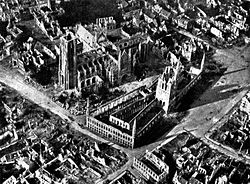- Cloth Hall, Ypres
-
The Cloth Hall (Dutch: Lakenhal or Lakenhalle), of Ypres, Belgium, was one of the largest commercial buildings of the Middle Ages, when it served as the main market and warehouse for the Flemish city's prosperous cloth industry. The original structure, erected mainly in the 13th century and completed 1304, lay in ruins after artillery fire devastated Ypres in World War I. Between 1933 and 1967, the hall was meticulously reconstructed to its prewar condition, under the guidance of architects J. Coomans and P.A. Pauwels. At 125 metres in breadth, with a 70-metre-high belfry tower, the Cloth Hall recalls the importance and wealth of the medieval trade city.
In a row spanning the front of the edifice are tall pointed arches that alternately enclose windows and blind niches. Before the Great War, the niches framed life-size statues of historical personages, counts and countesses of Flanders. The niches on the side wings are now mostly vacant, but those in the centre contain statues of Count Baldwin IX of Flanders and Mary of Champagne, legendary founders of the building; and King Albert I and Queen Elisabeth, under whose reign the reconstruction began. Situated between these two couples, directly above the central archway entrance or Donkerpoort, is a statue of Our Lady of Thuyne, the patron of Ypres.
The belfry, capped with four turrets and a spire, houses a carillon with 49 bells. From a pole atop the spire a gilded dragon overlooks the city. The tower offers an expansive view of the surroundings, and was used as a watchtower in centuries past. It has also accommodated the town archives, a treasury, an armory and a prison. In less enlightened times, cats, then associated in some way with black magic, were thrown off the belfry for reasons that are not clearly understood. Today, a jester commemorates this act by tossing stuffed toy felines from the tower during the triennial Cat Festival.
The Cloth Hall used to be accessible by boat via the Ieperlee waterway, which is now covered. The spacious ground-floor halls where wool and cloth were once sold are now used for exhibitions; the second floor, formerly a warehouse, now hosts the In Flanders Fields Museum, dedicated to the history of World War I.
Against the east face of the edifice stands the elegant Nieuwerck, whose Renaissance style contrasts markedly with the Gothic of the main building. Originally built between 1619 and 1622, and reconstructed after the war, this annex now serves as a town hall.
See also
- Belfries of Belgium and France (UNESCO World Heritage Site)
- Battle of Ypres
- Calcutta High Court, a 19th-century copy of the Cloth Hall in Kolkata, India
- Delaware and Hudson Railway Building, a 20th-century copy of the Cloth Hall in Albany, New York, United States
External links
- Ypres: The Cloth Hall from Trabel.com
- (Dutch) Description and picture gallery from Belgiumview
- In Flanders Fields Museum
Categories:- 1300s architecture
- Buildings and structures in West Flanders
- World War I museums
- Ypres
- Buildings and structures completed in 1967
Wikimedia Foundation. 2010.


